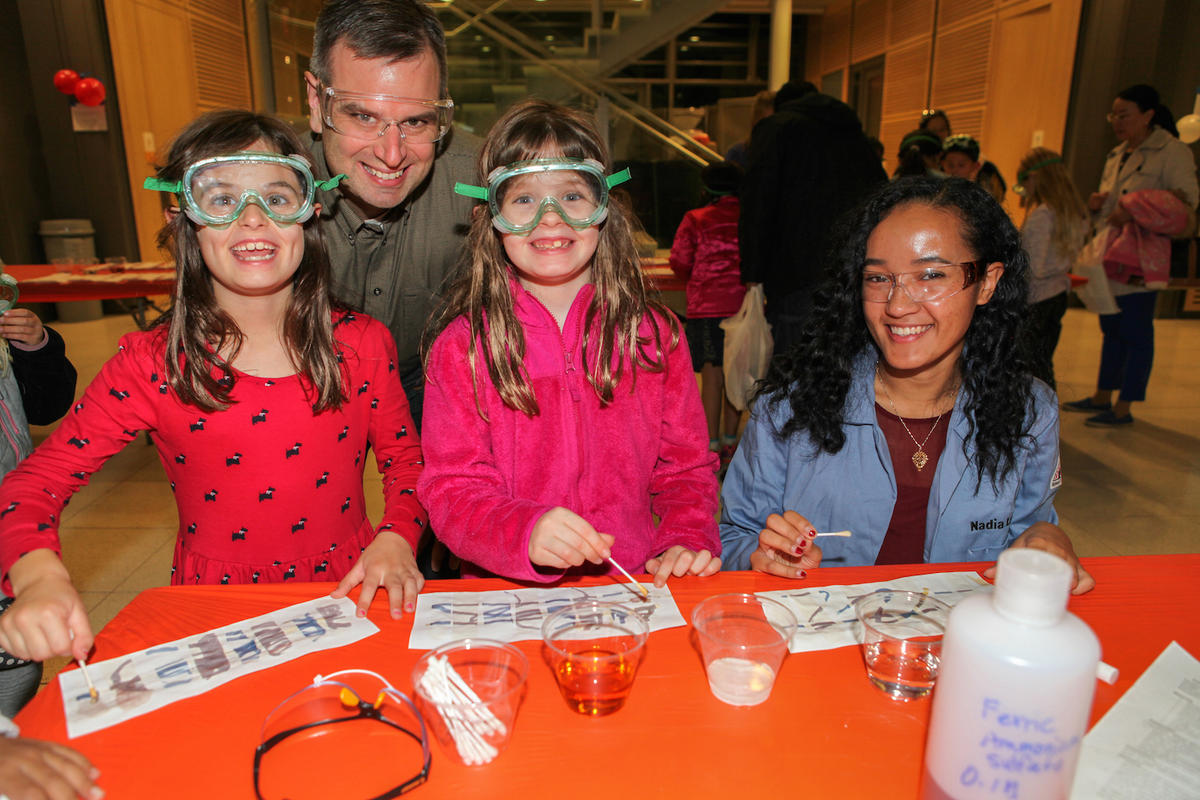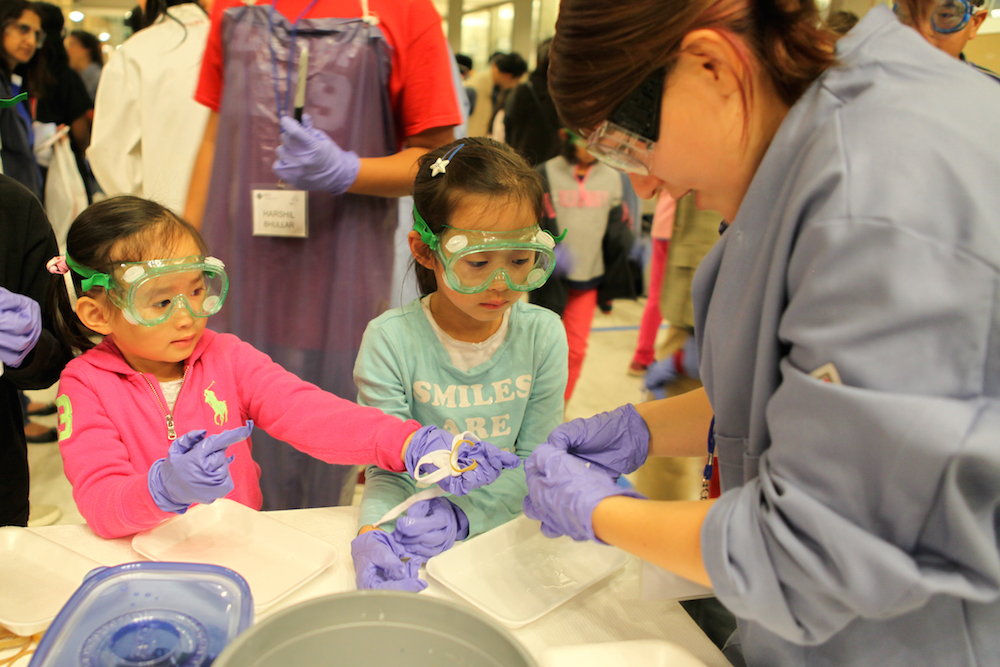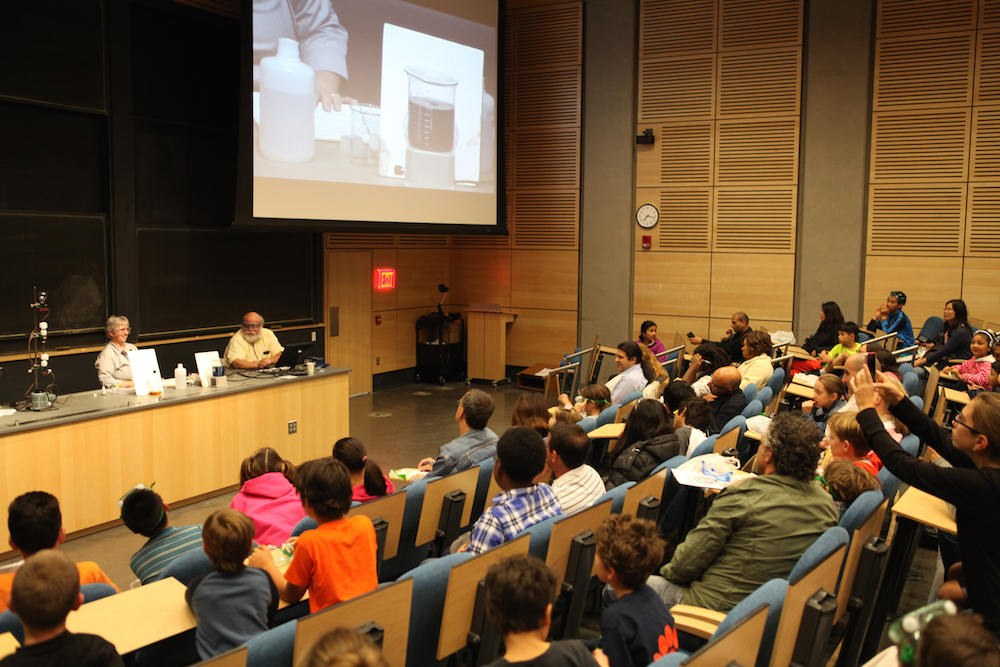National Chemistry Week Activities Night 2015: Chemistry Colors Our World

Last Friday evening, more than 450 community members visited Frick Chemistry Laboratory to learn about how chemistry colors our world at this year’s National Chemistry Week Activities Night.
Keisha Stephan, who teaches AP chemistry at Highland Park High School, watched with a smile as her daughters, Suzette and Simone, made patterns on coffee filters using the chromatography of colored inks. The girls were looking forward to the activities night, having attended every year for the past four years. The previous year’s theme was candy, and she said they were so excited about the candy activities that they didn’t want to leave. “They love science,” Stephan said.
On arrival, registered guests of all ages donned safety goggles and received an apron, a diffraction grating and a booklet from the American Chemical Society. The booklet explains topics from the chemistry of fireworks to why the sky is blue, accompanied by procedures for simple DIY experiments on color.
The crowd, mostly families, could participate in an auditorium show given by American Chemical Society members and local scientists and 9 different hands-on activities supervised by ACS members, local scientists, graduate students, undergraduates, and trained high school students. In total, 140 volunteers helped with the preparation, set-up, demonstration and cleanup of the night’s activities.
Members of the Scholes group, led by Bryan Kudisch, developed and supervised the Chemistry and Light activities, and a group of first-year graduate students, led by Dylan Abrams, organized the activity on chromatography of nature’s colors in leaves and berries. The event was organized by co-coordinators Kathryn Wagner and Louise Lawter, and jointly sponsored by Princeton University Department of Chemistry and the Princeton Local Section of the American Chemical Society.

Nadia Leonard, a second year graduate student in the Chirik group, stooped down to explain the chemistry of “magic paper” (white paper striped with solutions of tannic acid and potassium ferrocyanide) to her adviser’s young twin daughters. The girls dragged Q-tips wetted with a solution of iron(III) ions across the paper, and were delighted at the appearance of streaks of black and deep blue color. The iron(III) reacts with tannin to make a permanent black ink and with ferrocyanide to make Prussian blue.
Guests also had a chance to work in the general chemistry laboratory, thanks to organization efforts by Virginia Sari, a senior laboratory coordinator in the chemistry department. For the lab activity, guests mixed food dyes and shaving cream to make marbled paper, under the supervision of high school students from the Princeton International School for Mathematics and Science and their teacher, Roxanne Spencer, a Princeton chemistry graduate alumna.

At the far end of the atrium, students from Lawrence High School helped eager attendees don gloves and dye shoelaces with indigo dye. Emily Tino and Sophie Webster, both seniors, used paper cutouts to help small groups of kids and their parents understand how the dye sticks to the fibers and the chemical process of oxidation underlying the dye’s change in color from green to blue.
More advanced chemical reactions demonstrating the wonders of color were performed for a packed audience in Taylor Auditorium. As volunteers at the front of the room poured colorless liquids into a beaker where its contents were vigorously stirred for a so-called oscillating reaction, they asked the crowd what oscillating meant.
“Shaking,” a child in the front called out.
“Going back and forth,” said another young audience member.
The whole room watched as the solution took on a yellow hue and suddenly turned a deep blue, prompting clamoring from the crowd. Then the blue color lightened, eventually reverting to yellow and then blue again, with the audience oohs and aahs marking each color change.

